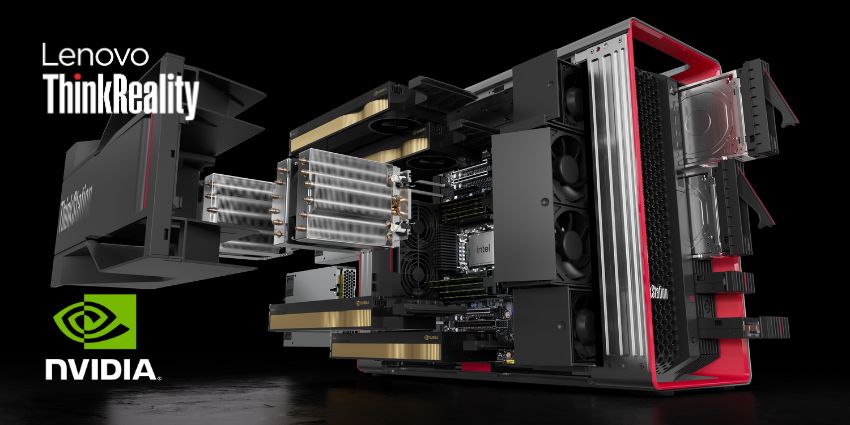Lenovo’s new Spatial Computing Appliance, which captured the attention of the real world at NVIDIA GTC 2024, features an integrated Lenovo ThinkStation PX and Lenovo ThinkReality VRX headset.
Lenovo’s most powerful workstation packs up to 120 CPU cores and four dual-slot GPUs, while still leaving room for 25GB of networking, delivering unprecedented content creation potential. That means the power to create content that replicates and extends the physical world, creating digital twins that can be used to model almost anything in a synergistic, collaborative environment.
As Gary Radburn, NVIDIA solutions manager for Lenovo’s Workstation Product Group, explains, digital twins are already transforming product development in many ways.
“The challenge that enterprise customers face is, ‘How can we do more with less? How can we enable more interactions faster? How can we get the right product to market with a shorter time to monetization?’” he explained.
The resource savings are obvious if you can replicate it digitally, especially when working on the scale of commercial construction, for example. But this is only possible if the digital twin accurately and completely replicates all the important aspects of the physical object.
Building Together in VR
“There are some great use cases in architecture when you consider the cost of actually developing a building,” Radburn said. “You can model a client’s vision within a digital twin environment long before you break ground. It’s much richer than a CAD-CAM environment. You can see how people will move through the building and model the HVAC systems that will be needed to support them. You can even model time-of-day simulations to see how desks should be positioned to block late afternoon sunlight from hitting your eyes.”
Lenovo’s collaboration with NVIDIA provides enterprises with the technology they need to support multi-user workflows and make these models a reality, explained Greg Jones, head of global XR business development at NVIDIA. The ability to collaborate in parallel opens up unprecedented potential.
“Connectors to popular applications like Unreal Engine and Blender mean everyone can work collaboratively on, test, and make changes to a dynamic digital twin rather than manually exploring it,” he explains.
With the Lenovo Spatial Computing Appliance, which includes a ThinkStation PX and four ThinkReality VRX headsets in a single device, all four users can have their own uncompromising virtual reality (VR) session via a high-speed wireless network. NVIDIA RTX professional GPUs render each user’s 3D experience, and also provide the ability for all four users to collaborate on an XR experience using AutodeskVRED, for example.
“With this USD enablement and these connectors, anyone can own their modifications in the simulation and then plug them into tools and applications developed on the NVIDIA Omniverse platform to do ray-traced rendering, which will show you properties like how light interacts with matter on a 40-foot wall,” Jones explained.
The combination of ThinkStation PX and NVIDIA RTX GPUs and the fidelity of ThinkReality VRX means you can visualize and render anything in matter and space. Users can visualize and iterate faster, get products to market, and generate revenue faster.
Training machines in infinite virtual environments
Of course, it’s not just buildings. Other digital twins reflect truly moving targets.
“We spend a lot of time at NVIDIA advancing autonomous vehicles,” Jones continued. “We drive our autonomous vehicles in massive simulations across trillions of miles to train AI much faster than any physical system. We can create any reality and test and train responses in complete safety.” And because of their collaborative environment, they can do this in parallel, training millions of robots at a time before they’re safely deployed on the road or in industrial manufacturing or logistics situations.
With enough computing power and imagination, digital twins can be used to model almost anything at any scale, from tiny robots to the entire city-state of Singapore. Singapore has built digital twins that map everything from urban development to the well-being of heritage trees, fed by sensors in the trees themselves. The technology can also be used on a planetary scale, as in the case of NVIDIA’s Earth-2 digital twin, which models climate change.
The convergence of Lenovo’s innovative hardware and NVIDIA’s cutting-edge software helps us make a meaningful leap forward in digital twin technology. This collaboration enhances our ability to model and interact with the physical world in ways we never imagined, improving efficiency, innovation, and sustainability across domains. With systems like the ThinkStation PX AI Workstation and tools and applications built on Omniverse and OpenUSD, the future of digital replication looks bright, paving the way for smarter, more connected digital environments while preserving our precious physical environment.

